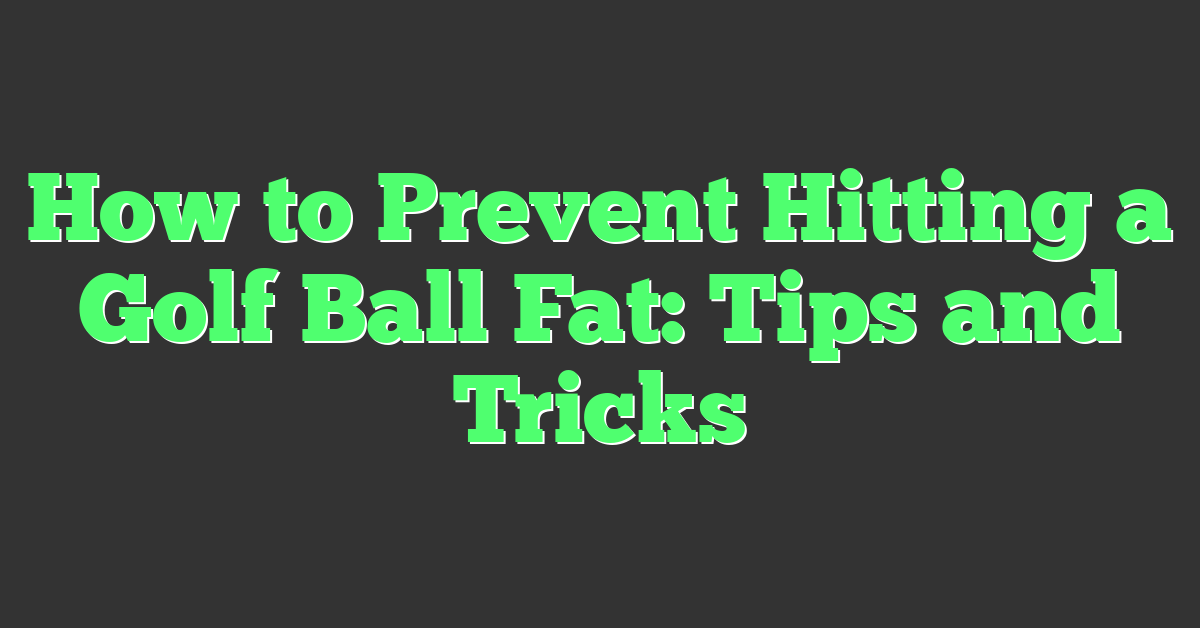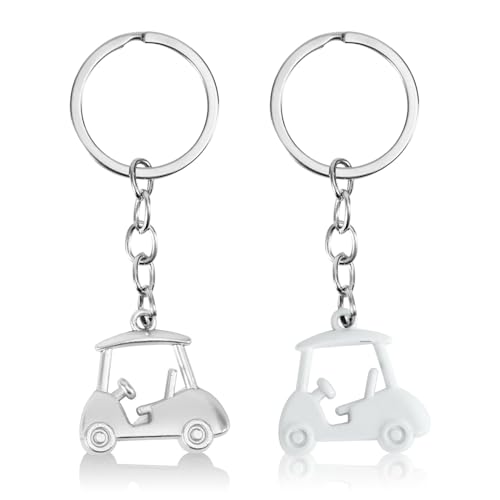Are you tired of consistently hitting your golf ball fat? Do you find yourself struggling to get the distance and accuracy you desire? Hitting the ball fat is a common problem for many golfers, but fortunately, it is a problem that can be fixed. In this article, we will provide you with tips and techniques to help you prevent hitting the ball fat and improve your golf game.

Understanding the fat shot is the first step in preventing it. A fat shot occurs when the clubhead strikes the ground before making contact with the ball, causing the shot to come up short and often veer off course. The most common cause of a fat shot is an incorrect setup, which can be easily fixed by adjusting your stance. Proper weight distribution, ball position, and posture are all essential elements of a good setup that can help you avoid hitting the ball fat.
Mastering the golf swing is also crucial in preventing fat shots. The golf swing is a complex movement that requires proper technique and timing. A good golf swing involves a smooth and consistent motion that generates power and accuracy. By focusing on the fundamentals of the golf swing, such as grip, alignment, and tempo, you can improve your swing and avoid hitting the ball fat.
Key Takeaways
- Proper setup and stance are essential in preventing fat shots
- Mastering the golf swing involves focusing on the fundamentals of grip, alignment, and tempo
- Practicing at the range and using proper equipment can help improve your golf game
Understanding the Fat Shot
https://www.youtube.com/watch?v=kwFb8m6bMCY&embed=true
If you’re a golfer, you’ve probably experienced the frustration of hitting a fat shot. A fat shot is when you hit the ground before the ball, causing the ball to travel a shorter distance than intended. In this section, we’ll take a closer look at the causes of fat shots and their effects on ball trajectory.
Causes of Fat Shots
There are several reasons why you might hit a fat shot. One common cause is standing too close to the ball. When you stand too close, your club will hit the ground before it reaches the ball. To avoid this, make sure you stand at the correct distance from the ball. Your arms should be hanging but not extended too far.
Another cause of fat shots is improper weight distribution. If you have too much weight on your back foot, you’ll hit the ground before the ball. To fix this, make sure you shift your weight to your front foot during your downswing.
Effects on Ball Trajectory
When you hit a fat shot, the ball won’t travel as far as it should. It will also have a lower trajectory and may not reach the intended target. Additionally, hitting the ground before the ball can cause you to take a large divot, which can damage the turf and make it harder for the next golfer to play their shot.
To prevent fat shots, make sure you’re standing at the correct distance from the ball and that your weight is properly distributed. Practice your swing and focus on hitting the ball first, then the ground. With practice, you’ll be able to hit consistently solid shots and avoid those frustrating fat shots.
The Importance of Proper Stance
https://www.youtube.com/watch?v=j9FHKsdd438&embed=true
When it comes to preventing fat shots in golf, one of the most important factors to consider is your stance. A proper stance can help you strike the ball more consistently and avoid hitting it fat. In this section, we will discuss two key aspects of your stance: stance width and ball position.
Stance Width
The width of your stance can greatly affect your ability to make solid contact with the ball. If your stance is too narrow, you may find it difficult to maintain your balance throughout the swing. On the other hand, if your stance is too wide, you may have trouble shifting your weight properly and generating power.
To find the right stance width for you, start by standing with your feet shoulder-width apart. From there, take a step back with your front foot and a step forward with your back foot. This should give you a slightly wider stance that will help you maintain your balance and generate power.
Ball Position
The position of the ball in your stance is another important factor to consider when trying to prevent fat shots. If the ball is too far forward in your stance, you may hit the ground before making contact with the ball, resulting in a fat shot. Conversely, if the ball is too far back in your stance, you may hit the ball thin or even miss it altogether.
To find the right ball position for you, start by placing the ball in the center of your stance. From there, take a few practice swings and adjust the ball position until you find the spot where you are making solid contact with the ball.
By paying attention to your stance width and ball position, you can greatly reduce your chances of hitting a golf ball fat. Remember, finding the right stance and ball position may take some trial and error, so don’t be afraid to experiment until you find what works best for you.
Mastering the Golf Swing
https://www.youtube.com/watch?v=kVtDvCB3IDo&embed=true
To prevent hitting a golf ball fat, it’s important to master your golf swing. This involves understanding the proper swing plane, downswing, and impact position.
Swing Plane
The swing plane is the angle at which the club travels during your swing. To achieve the correct swing plane, you should stand with your feet shoulder-width apart and align your club with your target. During your backswing, keep your club on the same plane as your shoulders. This will help you maintain a consistent swing path and prevent you from coming over the top, which can cause you to hit the ball fat.
Downswing and Impact
As you begin your downswing, shift your weight to your front foot and rotate your hips toward the target. This will help you generate power and maintain control. At impact, your hands should be slightly ahead of the ball, and your clubface should be square to your target. This will help you hit the ball cleanly and avoid hitting it fat.

To practice your downswing and impact, try hitting balls from a slightly downhill lie. This will help you focus on maintaining your balance and keeping your hands ahead of the ball.
By mastering your golf swing, you can prevent hitting the ball fat and improve your overall game. Remember to maintain a consistent swing plane, shift your weight during your downswing, and focus on your impact position. With practice, you’ll be able to hit the ball cleanly and consistently.
Weight Transfer Techniques
https://www.youtube.com/watch?v=JFnfBvYVtrA&embed=true
When it comes to preventing hitting a golf ball fat, weight transfer is an important technique to master. Here are some tips to help you shift your weight properly:
Shifting Weight Forward
During your downswing, make sure to shift your weight towards your front foot. This will help you strike the ball cleanly and avoid hitting it fat. To ensure that you’re shifting your weight forward properly, try this drill:

- Start with your feet shoulder-width apart and your weight evenly distributed between both feet.
- As you begin your downswing, shift your weight towards your front foot.
- At impact, the majority of your weight should be on your front foot.
Avoiding Hanging Back
One of the most common mistakes that golfers make is hanging back on their downswing. This can cause you to hit the ball fat, as your weight is not properly transferred to your front foot. To avoid hanging back, try the following:
- Focus on shifting your weight towards your front foot as you begin your downswing.
- Keep your head behind the ball at impact.
- Avoid lifting your front foot off the ground during your downswing.
By mastering weight transfer techniques, you can improve your balance and strike the ball more consistently. Remember to shift your weight forward during your downswing and avoid hanging back to prevent hitting the ball fat.
Golf Club Selection and Use
https://www.youtube.com/watch?v=jLq-IuC_N38&embed=true
Choosing the Right Clubs
Choosing the right club is crucial to prevent hitting the golf ball fat. If you’re not confident using a specific club, it’s better to avoid using it. In general, it’s recommended to use a club that you can hit consistently and accurately.
Irons and wedges are the best clubs to use when you’re close to the green. They are designed to help you hit the ball high and land it softly. When you’re farther away from the green, it’s better to use hybrids or fairway woods. They have a larger clubface and a lower center of gravity, which makes it easier to hit the ball cleanly.

Iron and Wedge Play
When it comes to iron and wedge play, there are a few things to keep in mind to prevent hitting the ball fat. First, make sure you’re hitting down on the ball. This means that your clubhead should be descending when it makes contact with the ball. Second, position the ball in the center of your stance. This will help you strike the ball cleanly and avoid hitting it fat. Third, keep your weight on your front foot throughout your swing. This will help you hit down on the ball and make solid contact.
It’s also important to choose the right type of wedge for the shot you’re facing. A sand wedge is ideal for bunker shots, while a pitching wedge is better for shorter shots around the green. Finally, practice your chipping and pitching regularly to develop a consistent and reliable technique.
Remember, choosing the right clubs and using them correctly is essential to prevent hitting the golf ball fat. By following these tips and practicing regularly, you can improve your game and lower your scores.
Practicing at the Range
Practicing at the range is a great way to improve your golf game and prevent hitting the ball fat. Here are some tips to help you make the most out of your range sessions.
Drills for Consistency
Consistency is key when it comes to golf shots. To improve your consistency, try practicing with a specific target in mind. Set up some targets on the range and aim for them with each shot. This will help you focus on your aim and improve your accuracy.
Another great drill for consistency is to practice hitting the ball with different clubs. Start with your driver and work your way down to your wedges. This will help you get a feel for each club and improve your overall game.
Using Training Aids
Using training aids can also help you prevent hitting the ball fat. One great training aid is a swing plane trainer. This will help you keep your swing on the correct plane and prevent you from hitting the ball fat.
Another useful training aid is a weighted club. This will help you develop more strength in your swing and improve your overall ball striking ability.
In addition to using training aids, it’s important to practice your shots from different lies. Try hitting shots from uphill, downhill, and sidehill lies. This will help you prepare for different situations on the course and improve your overall game.
Remember, practicing at the range is not just about hitting balls. It’s about improving your game and developing good habits. Take your time and focus on the fundamentals of your swing. With practice, you’ll be hitting the ball consistently and avoiding those fat shots in no time.

Equipment Considerations
When it comes to preventing fat shots, equipment considerations are often overlooked. However, the right equipment can make a significant difference in reducing the number of fat shots you hit.
The Role of Shafts
One of the most critical equipment factors to consider is the type of shaft you are using. Graphite shafts are generally more forgiving than steel shafts. They can absorb more vibration, which means that mishits are less likely to result in a fat shot. If you are currently using steel shafts and struggling with fat shots, it might be worth considering switching to graphite.
Clubhead Features
Another equipment consideration is the features of the clubhead. For example, wider soles can help prevent fat shots by making it easier to get the ball in the air. If you struggle with getting the ball airborne, wider soles might be a good option for you. Additionally, forgiving clubheads can also help reduce the number of fat shots you hit. Forgiving clubheads have a larger sweet spot, which means that mishits are less likely to result in a fat shot.
Overall, while equipment considerations are not a magic solution to preventing fat shots, they can certainly help. Consider trying out different shafts and clubheads to see if they make a difference in your game.
Physical and Mental Preparation
To prevent hitting a golf ball fat, physical and mental preparation are both crucial. Golf fitness and focus and concentration are two important aspects of preparation that can help you avoid hitting fat shots.

Golf Fitness
Improving your golf fitness can help you maintain balance and control throughout your swing. A regular exercise routine that includes strength training, flexibility exercises, and cardiovascular conditioning can help you build the strength and endurance needed to play golf at your best.
When it comes to preventing fat shots, balance is key. Golf fitness exercises that focus on core strength, such as planks and side planks, can help you maintain proper balance and alignment during your swing. Additionally, flexibility exercises, such as stretching and yoga, can help you maintain a full range of motion, which can help you maintain proper alignment and prevent fat shots.
Focus and Concentration
Maintaining focus and concentration throughout your round can also help you prevent fat shots. Before each shot, take a moment to visualize the shot you want to make. Focus on the target and imagine the ball going exactly where you want it to go.
Proper alignment and setup are also important for preventing fat shots. Take the time to properly align your body and clubface with your target. Make sure your feet, hips, and shoulders are all aligned parallel to your target line. Additionally, make sure your ball position is correct for the club you are using.
Finally, focus on the sequence of your swing. Make sure you are starting your swing with your hips and shoulders, rather than your hands and arms. This will help you maintain proper control and prevent fat shots.

By focusing on golf fitness and mental preparation, you can improve your balance, control, alignment, and sequence, all of which are important for preventing fat shots.
Common Mistakes to Avoid
If you are struggling with hitting fat shots, there are some common mistakes that you should avoid. By addressing these issues, you can improve your swing and avoid mishits.
Incorrect Setup
One of the most common reasons for hitting fat shots is an incorrect setup. Make sure that you are standing the correct distance from the ball. If you are too close, you will hit the ground before the ball. If you are too far, you will hit the ball thin. Finding the right distance can take some trial and error, but it is worth the effort.
Also, check your posture. Your arms should be hanging naturally, not extended too far. Keep your spine straight and your weight balanced between your feet.
Early Release and Flipping
Another common mistake that can lead to fat shots is an early release and flipping of the wrists. This occurs when you release the club too early, before impact. This can cause the club to hit the ground before the ball, resulting in a fat shot.
To avoid this, focus on keeping your wrists firm through impact. Imagine that you are squeezing a tube of toothpaste in your left hand (for right-handed golfers). This will help you maintain your wrist angle and prevent flipping.
By avoiding these common mistakes, you can improve your swing and prevent fat shots. Keep practicing and remember to stay relaxed and focused on your technique.
Advanced Tips and Techniques
If you have tried all the basic tips and techniques to prevent hitting a golf ball fat and still struggling to improve your swing, then it’s time to move on to advanced tips and techniques. These tips and techniques are designed to help you take your game to the next level.
Professional Guidance
One of the best ways to improve your golf game is to seek professional guidance from a golf coach or instructor. A professional coach can help you identify your weaknesses, correct your mistakes, and develop a personalized training plan to improve your swing.
When looking for a golf coach, choose someone who has experience working with golfers of all skill levels and has a good reputation in the golfing community. A good coach should be able to provide you with personalized feedback, demonstrate proper techniques, and help you develop a practice routine that suits your needs.

Video Analysis
Video analysis is another effective way to improve your golf game. By recording your swing and analyzing it frame by frame, you can identify areas where you need improvement and make the necessary adjustments.
When recording your swing, make sure to use a high-quality camera that can capture your swing from different angles. You can also use specialized software to analyze your swing and compare it to that of top golfers.
During the analysis, pay attention to your posture, grip, stance, and swing path. Look for any areas where you are not following proper technique and work on correcting them.
By incorporating these advanced tips and techniques into your training routine, you can take your golf game to the next level and achieve greater success on the course.
Troubleshooting and Adjustments
Analyzing Divot Patterns
One way to troubleshoot your fat shots is to analyze your divot patterns. If your divot is deep and in front of the ball, it’s a sign that you’re hitting the ground before making contact with the ball. This is a common cause of fat shots. On the other hand, if your divot is shallow and after the ball, you may be hitting the ball thin.

To adjust your divot pattern, try adjusting your distance to the ball. Stand farther away if your divot is in front of the ball, and closer if it’s behind the ball. You can also try adjusting your swing path, which we’ll cover in the next subsection.
Adjusting Swing Path
Another way to prevent hitting the ball fat is to adjust your swing path. A common cause of fat shots is a swing path that is too steep. This means that your club is coming down too steeply, causing it to hit the ground before the ball.
To adjust your swing path, try focusing on making a shallower swing. This can be achieved by keeping your shoulders level and turning them throughout the swing. You can also try making a wider swing, which will encourage a shallower swing path and directly oppose fat tendencies.
Remember to make these adjustments gradually and not all at once. It’s important to find what works best for you and to practice consistently. With a little patience and persistence, you can prevent hitting the ball fat and improve your distance and trajectory.











